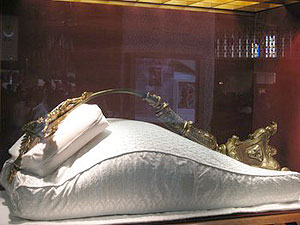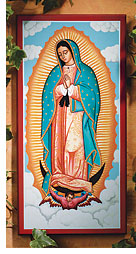 In the winter of 1531 the Virgin Mary appeared to Saint Juan Diego, a humble Mexican Indian peasant, instructing him to tell the local bishop of her desire for the construction of a new basilica dedicated to her. Begging for a sign to convince the Bishop, Saint Juan Diego was told to climb to the stony summit of Tepeyac where he would find miraculously blooming roses he was to gather in his mantle (or tilma) and take to the Bishop. Opening his mantle to show the roses, all were astonished to see the Virgin Mary's colorful portrait miraculously imprinted on the coarse fabric of Saint Juan's mantle. This tilma has been preserved to this day in the Basilica of Our Lady of Guadalupe in Mexico City. For the full account of the apparition and miracle of the tilma, read
The Apparitions of the Blessed Virgin Mary to Saint Juan Diego.
In the winter of 1531 the Virgin Mary appeared to Saint Juan Diego, a humble Mexican Indian peasant, instructing him to tell the local bishop of her desire for the construction of a new basilica dedicated to her. Begging for a sign to convince the Bishop, Saint Juan Diego was told to climb to the stony summit of Tepeyac where he would find miraculously blooming roses he was to gather in his mantle (or tilma) and take to the Bishop. Opening his mantle to show the roses, all were astonished to see the Virgin Mary's colorful portrait miraculously imprinted on the coarse fabric of Saint Juan's mantle. This tilma has been preserved to this day in the Basilica of Our Lady of Guadalupe in Mexico City. For the full account of the apparition and miracle of the tilma, read
The Apparitions of the Blessed Virgin Mary to Saint Juan Diego.
The man in the Virgin's eyes
In 1929, Alfonso Marcue, the official photographer of the old Basilica of Guadalupe in Mexico City, discovered a clear image of a bearded man reflected in the right eye of the Virgin. He informed the authorities of the Basilica, who told him to keep complete silence about the discovery, which he did.
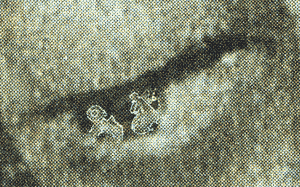
What the ophthalmologists found
In 1956 ophthalmologist Dr. Rafael Torrija Lavoignet examined the eyes of the Virgin's image with an ophthalmoscope in great detail. He observed the apparent human figure in the corneas of both eyes, with the location and distortion of a normal human eye and specially noted a unique appearance of the eyes: they look strangely "alive" when examined. Earlier that same year ophthalmologist Dr. Javier Torroella Bueno certified that the images in the Virgin's eyes are located where they would be in a living human eye, and that the distortion of the images agree with the curvature of the cornea.
A "miraculous painting"? Or a "heavenly photograph"?
In 1979, when working with digitized high-resolution images of the tilma magnified 2,500 times, Dr. Jose Aste Tonsmann discovered that in addition to the human bust others had seen previously, other human figures were reflected in the Virgin's eyes -- a total of thirteen people. The same people are present in both the left and right eyes, in different proportions, as would happen when human eyes reflect the objects before them.
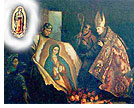 Tonsmann said he believes the reflection transmitted by the eyes of the Virgin of Guadalupe is the scene on Dec. 9, 1531, during which Juan Diego showed his tilma, with the image, to Bishop Juan de Zumárraga and others present in the room. Nuclear physicist Dr. Charles Wahlig also posited that the Blessed Mother must have been invisibly present when Juan Diego was presenting the roses to Bishop Zumarraga and that the tilma acted like a photographic plate that captured her image and the reflection of their images in her eyes.
Tonsmann said he believes the reflection transmitted by the eyes of the Virgin of Guadalupe is the scene on Dec. 9, 1531, during which Juan Diego showed his tilma, with the image, to Bishop Juan de Zumárraga and others present in the room. Nuclear physicist Dr. Charles Wahlig also posited that the Blessed Mother must have been invisibly present when Juan Diego was presenting the roses to Bishop Zumarraga and that the tilma acted like a photographic plate that captured her image and the reflection of their images in her eyes.
In the eyes, Tonsmann discerned a seated Indian, who is looking up to the heavens; the profile of a balding, elderly man with a white beard, much like the portrait of Bishop Zumárraga painted by Miguel Cabrera to depict the miracle; and a younger man, probably interpreter Juan González.
In the eyes, Tonsmann discerned a seated Indian, who is looking up to the heavens; the profile of a balding, elderly man with a white beard, much like the portrait of Bishop Zumárraga painted by Miguel Cabrera to depict the miracle; and a younger man, probably interpreter Juan González.
Also present is an Indian of striking features with a beard and mustache, likely Saint Juan Diego who unfolds his own tilma before the bishop; a woman of dark complexion, possibly a Negro slave who was in the bishop's service; and a man with Spanish features who looks on pensively, stroking his beard with his hand.
A blessed family
In the center of the pupils, on a much more reduced scale, another scene can be perceived, independent of the first, the scientist contends. It is that of an Indian family made up of a woman, a man and several children. In the right eye, other people who are standing appear behind the woman.
How can a cloth painting last almost 500 years?
Infra-red studies also revealed other unexplainable phenomena: The image was not painted, and the color did not penetrate the fibers as would paint. Weaving with such irregular fibers also produced a rough surface which would have distorted any simple surface painting, yet the image one sees is clear and undistorted.
Richard Kuhn, the 1938 Nobel Prize winner in chemistry, found that the image did not have natural animal or mineral colorings. Given that there were no synthetic colorings in 1531, the image is inexplicable.
Dr. Tonsmann insisted that the basic image had not been painted by human hand. Made of the "ayate" fibers used by the Indians, the tilma should have deteriorated centuries ago. It was not sized and has no protective coat of varnish. Anything of cactus fiber would have deteriorated within a hundred years, especially when exposed to the pollution, candle soot, and the like. Nevertheless, the tilma remains.
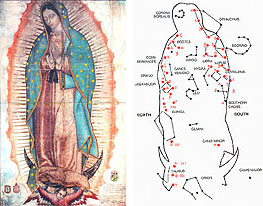
Queen of the Heavens
The research of Father Mario Sanches and Dr. Juan Hernandez Illescas of Mexico attests that the stars on the mantle appear exactly as they would have in the sky before dawn on the morning of Dec. 12, 1531. Above are two images. The first image is the Missionary Image on which the stars on the mantle of the image have been brightened. The second image is a constellation map from a documented source.
Invincible Queen
In 1921, during the fanatical reign of General Calles who outlawed Catholicism, a bomb was planted in the basilica in hopes of destroying the tilma. The bomb reduced to rubble the marble altar below the tilma, shattered the windows, twisted the heavy bronze altar cross, and the tilma was...untouched! Even its glass covering was undamaged. Indeed, no one was injured in the Church despite the damage that occurred to a large part of the altar structure.
